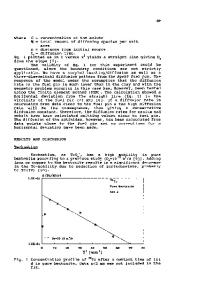Migration Behavior of Ferrous Ions in Compacted Bentonite under Reducing Conditions using Electromigration
- PDF / 549,259 Bytes
- 6 Pages / 612 x 792 pts (letter) Page_size
- 59 Downloads / 322 Views
CC8.47.1
Migration Behavior of Ferrous Ions in Compacted Bentonite Under Reducing Conditions Using Electromigration Kazuya Idemitsu, Xiaobin Xia, Yoshiro Kikuchi, Yaohiro Inagaki, Tatsumi Arima, Dept of Applied Quantum Physics and Nuclear Engineering, Kyushu Univ., Fukuoka, JAPAN [email protected] ABSTRACT Carbon steel is one of the candidate overpack materials for high-level waste disposal and is expected to assure complete containment of vitrified waste glass during an initial period of 1000 years in Japan. The lifetime of the carbon steel overpack will depend on its corrosion rate. The corrosion rate of carbon steel is reduced by the presence of buffer material such as bentonite. Buffer material will delay the supply of corrosive materials and discharge of corrosion products through it. Carbon steel overpack will be corroded by consuming oxygen introduced by repository construction after closure of repository and then will keep the reducing environment in the vicinity of repository. Therefore, it is important to study the migration of iron corrosion products through the buffer material because it may affect the corrosion rate of overpack, migration of redox-sensitive radionuclides, and the properties of the buffer material. Electromigration experiments have been carried out with source of iron ions supplied by anode corrosion of iron coupon in compacted bentonite. The carbon steel coupon was connected as the working electrode to the potentiostat and was held at a constant applied potential between - 200 to 1000 mV vs. Ag/AgCl electrode for 48 hours. Corrosion currents were 0.5 to 2mA initially and depended on the supplied electrical potential, then decreased to approximately 0.1 mA in a few hours. The final corrosion current was independent of supplied electrical potential. It is expected that iron ion could migrate as ferrous ion through interlayer of montmorillonite replacing exchangeable sodium ions in the interlayer. The rate-determining process of this experimental configuration could be infiltration rate of ferrous ion into bentonite. Infiltration rate of ferrous ion into bentonite was increasing with dry density of bentonite. INTRODUCTION Carbon steel is one of the candidate overpack materials for high-level waste disposal and is expected to assure complete containment of vitrified waste glass during an initial period of 1000 years in Japan [1]. The corrosion rate of carbon steel is reduced by the presence of buffer material such as bentonite [2,3] and seems to be affected by the diffusion of corrosive materials and corrosion products through the buffer material. Carbon steel overpack will be corroded by consuming oxygen introduced by repository construction after closure of repository and then will keep the reducing environment in the vicinity of repository. The reducing condition will be expected to retard the migration of redox-sensitive radionuclides such as uranium [4], technetium [5] and so on [6] by lowering their solubilities and diffusivities. Therefore, it is important to study the mi
Data Loading...











